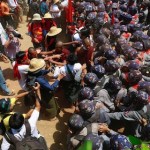The clashes earlier in March in Myanmar between student protestors and the police, have once again highlighted how, the country continues to struggle between distancing itself from its dictatorial past while also returning to the methods of its previous authoritarian rule. In the general election planned in the country for late October/early November, this struggle—between reform and a return to the past—will be a critical factor.
After the President Thein Sein government was elected in 2011, it embarked on a number of reforms—political prisoners were released, controls on the media were relaxed, and peace agreements with numerous armed ethnic groups were signed. The reforms were welcomed by the people of Myanmar, and the international community eased sanctions and encourged investment in the country.
But those early successes have gradually come to be overshadowed by a reversal of the reforms and a continual stalling of the peace process.
It is in this dual process—of reform and backtracking—that the recent students’ protests are located. On 30 September 2014, a draft National Education Bill was passed by Parliament. However, students’ groups said the bill is gives too much power to the government, limits the autonomy of universities, and imposes excessive restrictions on the formation of student unions. Various students’ groups have since been protesting to get the bill amended.
It became clear that the reforms have severely weakend when the Swan Arr Shin (Masters of Force), a civilian group frequently used by the government as an auxiliary police force, was sent in to control the students. In 2007, the Swan Arr Shin was particularly violent in suppressing protesting monks in the Safforn Revolution; on 5 March 2015, in plainclothes with red armbands emblazoned with the Burmese word for duty, the Masters of Force violently dispersed the students protesting outside Yangon City Hall.
There is little doubt that the Myanmar Police Force is under-equipped and badly trained. However, the European Union has, since early 2014, embarked on a rigourous training programme designed to bring the force in line with modern policing methods, including crowd control techniques. The training is scheduled to end this month, March 2015.
But the recent clashes, in which baton-wielding police officers assaulted civilians, suggest that the training has had little impact. Besides, when Yangon City Hall already has a resident police contigent, why was it necessary to depute the civilian militia to disperse the hundred or so protestors?
The Thein Sein government has said that the decision to use the civilian militia was taken locally, by the Yangon regional administration, and it has distanced itself from the use of such tactics against the protestors.
In keeping with this distancing, on 10 March 2015 the government announced that it was forming a commission to investigate whether: ‘’…security forces acted properly in dispersing the protesters, and whether the authorities responsible acted in line with legal procedures, while also seeking measures to prevent such cases in the future.’’ [1]
Despite this announcement, on the same day, the police at Letpadan too used force against the student protesters; 16 police officers and eight protesters were injured, and 127 were arrested.
To the people of Myanmar, all this is further proof that the reforms are slipping back.
The country’s armed ethnic groups, who continue to negotiate for peace and have met the Government seven times so far to discuss a nationwide ceasefire agreement and a future political dialogue, are making their own careful assesment of the changing situation.
The Karen National Union has publically expressed its concerns about the crackdown on the student protestors. The Union is one of the largest armed ethnic groups that has commited to signing a nationwide ceasefire agreement with the government. It is seen as the most likely, along with the Restoration Council of Shan State, to agree to a negotiated a peace deal. The United Nationalities Federal Council, a coalition of ethnic armed organisations, has also issued a statement criticising the government’s approach to dissent.
Their opposition to the govermnent’s tactics may have a far-reacing impact, because one of the greatest obstacles in the ethnic peace process in Myanmar remains a lack of trust in the Government and the use of violence agaist peaceful protestors could further diminish any hard-earned trust. It also provides more ammunition to critics of the peace process, who constantly highlight the government’s backtracking on reforms.
On other fronts too, the Thein Sein government’s initial reforms have eroded. The number of political prisoners has increased, journalists have been arrested, inter-community violence has continued, Buddhist extremism is growing, discriminatory laws have been enacted, and the ethnic conflict on the Chinese border is persistent—and all these factors continue to challenge the reforms.
The violent suppression of student protestors is likely to further seriously hamper the chances of President Thein Sein being elected for a second term. While the people of Myanmar, especially in urban areas, have supported the president on various issues, especially the ongoing peace process and dialogue on federalism, the use of violence against protestors resembles too closely the brutal crushing of demonstrations in the past.
But if a new Government comes to power, will it continue the reforms and honour peace agreements without dictating new terms to the ethnic groups? This too remains uncertain.
References
[1] The Republic of the Union of Myanmar, President office, Gov’t forms inquiry commission into protest dispersal in front of Yangon City Hall, 10 March 2015, <http://www.president-office.gov.mm/en/?q=briefing-room/2015/03/11/id-5122>
Paul Keenan is a British researcher on Myanmar and author of ‘By Force of Arms – Armed Ethnic Groups in Burma’ (Vij Books, India, 2013) and co-author of ‘Ending Ethnic Armed Conflict in Burma’ (BCES Press, Thailand, 2014).
This article was exclusively written for Gateway House: Indian Council on Global Relations. You can read more exclusive content here.
For interview requests with the author, or for permission to republish, please contact outreach@gatewayhouse.in.
© Copyright 2015 Gateway House: Indian Council on Global Relations. All rights reserved. Any unauthorized copying or reproduction is strictly prohibited


